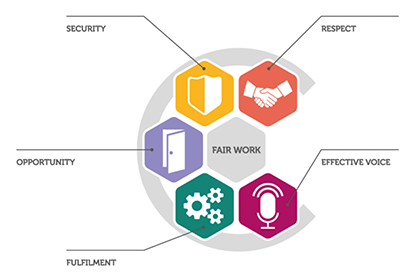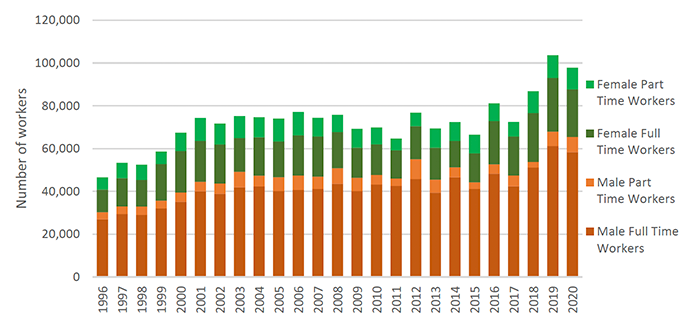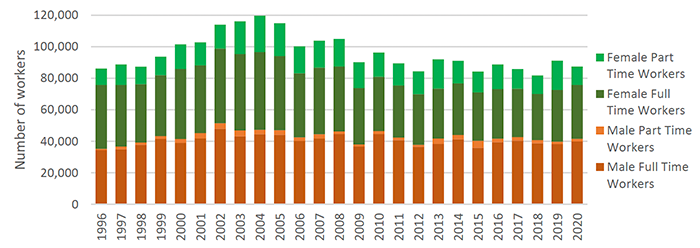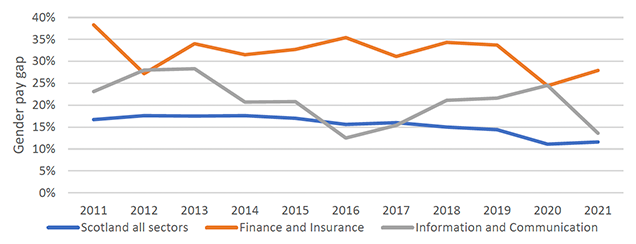Chapter One: Introduction
1.1 Background
The number of older workers in Scotland has hit a record high in recent years, with workers over 50 now comprising nearly a third (33.2%) of the Scottish workforce.[2] The ageing nature of the workforce has given rise to several important policy and legislative changes, most notably the extension of the state pension age, and the inclusion of age as a protected class in the 2010 Equalities Act. However, older workers continue to face considerable barriers in the workplace, and the nature and extent of these barriers is highly gendered. In particular, older women experience a unique set of workplace inequalities, evidenced not only by the existence of pay disparities in relation to men, but also by the persistence and worsening of these disparities over the course of their lives. In Scotland, the gender pay gap (GPG) for all employees – including full and part-time employees – is highest for women aged 50-64, according to the most recent data analysed by the Scottish Government.[3] This finding corresponds with UK-wide data.[4]
In this context, the Fair Work Convention commissioned the National Institute of Economic and Social Research to explore experiences of pay and progression among women over 50 in the workplace in Scotland. The Fair Work Convention is an independent body that advises the Scottish Government on advancing fair work for all in Scotland. The Convention's 2016 Framework defines fair work as work that offers individuals effective voice, opportunity, security, fulfilment, and respect.[5] The Convention works with government, employers, unions, and other stakeholders to promote these five key dimensions of fair work.

In order to provide focus to the research, this project looked at two specific sectors: the Finance and Insurance sector, and the Information and Communication sector. The project involved qualitative research with both female workers over 50 and with employers, in order to gain in-depth perspectives on women's lived experiences of the workplace. The research provides an evidence base for recommendations for new workplace practices aimed at removing barriers to progression among women over 50 in Scotland.
1.2 Methodology
We carried out 13 interviews with employers in Scotland in January and February 2022. These interviews were all conducted by video link and lasted approximately 60 mins. Employers were not offered any reward for their participation. Six of these employers were within the Finance and Insurance sector, and seven were within the Information and Communication sector. Six of these organisations had under 20 employees, two had between 50-80 employees, and five had over 250 employees. Out of these five larger organisations, three organisations had 1000 or more employees. The majority of the employers that we interviewed were based only in Scotland, although six employers had branches or parent companies outside Scotland.
In smaller organisations, interviews were typically conducted with managing directors or CEOs. In larger companies, interviews were conducted with HR directors or HR managers. These companies were based in a wide range of locations throughout Scotland, including Edinburgh, Dundee, Glasgow, and Inverness. All of the organisations that we interviewed employed at least two or more women over 50, with the exception of one organisation which had employed women over 50 in the past but no longer did.
In order to recruit employers, we contacted 1787 employers via email in the relevant sectors using an employer database supplied by a company called Market Location. We received expressions of interest from 20 employers, and we ultimately selected 10 employers who met our requirements for interview. We selected employers based on their area of work, the number of women over 50 in their workforce, their total number of employees, and their location in Scotland. Our remaining three employers were recruited through existing contacts of the Fair Work Convention.
In addition, we carried out 17 semi-structured interviews with women over 50 in Scotland in January and February 2022. The interviews were carried out by telephone or video link and lasted around 60 minutes each. Women were paid £40 in the form of a shopping voucher for their participation. Nine women worked in the Finance and Insurance sector, while eight worked in the Communication and Information sector.
Approximately half the women we interviewed were between 55 and 60 years old, while a quarter of our sample were between 50 and 55 years old, and a further quarter were between 60 and 65 years old. They lived in a variety of locations across Scotland, including Glasgow, Stirling, Dundee, Dunfermline, Edinburgh, and Inverness.
All the women were employed at the time of the interview, with the exception of one woman who had taken early retirement from a large bank a few years earlier. Our sample included women with varying levels of pay and responsibility in the workplace, ranging from senior managers in the finance sector, to administrative and call-centre workers who tended to be on lower pay and have lower levels of responsibility.
In order to recruit women, we asked every employer that we interviewed to circulate information via email to their employees about our research project. This email invited women over 50 to contact us directly using a private email if they wished to participate in our research. Both employers and employees were assured their confidentiality and anonymity would be protected at every stage of the research. The majority of the women that we interviewed were recruited in this way. In addition, we also recruited a small number of women using a 'snowball technique': this involved asking women that we interviewed to circulate details of our research project to their colleagues. Finally, we recruited four women through the existing networks of the Fair Work Convention, particularly trade union networks. In total, we interviewed 11 women at organisations where we had also conducted an employer interview. The women in our sample were drawn from a total of 10 different employers, meaning that on average we interviewed two women at each employer.
All the names of employers and employees used in this report are pseudonyms in order to protect the privacy of research participants. We have also changed the job titles, ages, and other characteristics of employees, while ensuring that we retain the overall integrity of the data by choosing descriptions that reflect the overall social structures identified in the research. Similarly, we have made some changes to descriptions of employers and the nature of their work, while maintaining the overall integrity of the data.
The interview topic guides can be found in Appendix B.
Strengths and limitations of the data
The evidence in this report is based on qualitative research that is not – and does not set out to be – representative of the wider population. Instead, the research has focused on generating in-depth insights on the lived experiences of 17 women over 50 working in two sectors, as well as on the concerns and priorities of 13 employers in these two sectors.
In creating this sample of women and employers, we selected women with a range of a different job types, levels of responsibility, and pay, working in a range of different organisations across Scotland. Similarly, we interviewed employers of varying sizes and structures, in a variety of industries. This sampling strategy allowed us to explore a breadth of experiences within these sectors, and to look for both commonalities and differences between women and between employers. Moreover, by conducting semi-structured qualitative interviews, we were able to generate detailed and textured data on the experiences and perspectives of our interviewees. Semi-structured interviews also ensure that data collection is led by the participants' priorities and views, rather than by any prior assumptions of the interviewer. This has allowed us to generate recommendations that we believe will benefit many women in similar situations within and beyond these sectors.
Our research is not, however, intended to be representative of all women or employers. The group of women and employers involved in this study come from two selected sectors. Nor was our sample representative of all women who work in these two sectors. We note, for example, that our sample of female workers only included women who identified as white. Nor did we interview any women who disclosed a disability or any other protected characteristics. We anticipate that women's experiences of pay and progression are significantly affected by these intersecting identities but this was, unfortunately, beyond the scope of this research project. We also note the vast variety of job roles and business types within the two sectors, not all of which were captured within our sample. For this reason, we would encourage that further research explores the applicability of our recommendations to women in different circumstances within these sectors, and to women in other sectors.
Similarly, the employers included in our research will not be representative of all employers within these sectors. Given that we asked employers to volunteer themselves to be interviewed, it is likely that we have interviewed employers that feel particularly confident in their approach to women's pay and progression or, conversely, that have particular concerns in this area. Indeed, our sample includes employers that have undertaken a range of actions on their GPG, as well as those that have undertaken none. Our sample also includes companies that have considered at length the issues faced by women over 50, as well as those that have not. By including this diverse range of approaches within our sample, we have been able to capture a wide range of experiences among employers in relation to women over 50, and highlight a range of concerns and priorities.
Finally, it is important to note that the research is designed to understand the experiences of a sample of women aged over 50 at this point in time –in 2022. It does not intend to draw any significant conclusions about past or future cohorts of women over 50.
1.3 Context
The findings and recommendations in this report are likely to be informative and at least partly applicable to the economy as a whole. However, it is important to note that this report focused specifically on two sectors, in order to provide focus to the research, and to remove any confounding factors generated by differences across sectors. Those sectors were the Finance and Insurance sector (Standard Industrial Classification (SIC) 2007 Section K), and the Information and Communication sector (SIC 2004, Section J). They are both predominantly service-oriented but employ different proportions of female workers in Scotland. Women account for 33% of workers in Information and Communication. The size of the total workforce in this sector has increased over the past 20 years, but the proportion of women has remained stable (Figure 1). By comparison, women account for 52% of workers in Finance and Insurance, falling slightly over the past 20 years (Figure 2). As the graphs below show, in both sectors, women are more likely to work part-time compared to men. Appendix A provides the detailed figures.

Source: ONS Annual Population Survey.

Source: ONS Annual Population Survey.
The GPG in these sectors varies considerably. The median GPG for all employees, both those full-time and part-time, was 13.6% in the Information and Communication sector and 27.9% in the Financial and Insurance sector, according to the most recent ONS data from 2021.[6] In other words, men are paid more than women in both sectors. Importantly, the GPGs in both sectors are greater than the average GPG across all sectors in Scotland (Figure 3). Moreover, the general trend is that neither sector has shown significant progress in recent years in terms of improving their respective GPGs, though there has been a slight downward trend during the past decade. However, due to small sample sizes, the sector-specific estimates in Figure 3 should be treated with caution, and more so for Information and Communication than Finance and Insurance. This uncertainty is also reflected in the large variations from year to year.

Source: ONS Annual Survey of Hours and Earnings. Note that the sector-specific estimates are fairly imprecise due to small sample sizes, which explains the large variations from year to year. The estimates may also be further affected by Covid impacts in 2020 and 2021. Footnote 6 has the most recent figures for both full-time and part-time employees.
1.4 The report
The report consists of this Introduction plus three additional chapters. Chapter Two looks at views on pay and progression in the workplace among both women and employers. It explores how women view their past and present pay, as well as their past and present opportunities for progression, such as promotions, moving jobs, or undergoing training. The chapter also explores women's views on how age and gender have affected their pay and progression, highlighting a range of issues that women perceive as barriers to their progression. The chapter further looks at how employers view these issues, focusing in particular on any actions they have or have not taken to facilitate the progression of women over 50.
Chapter Three looks at women's experiences of health and well-being in the workplace, focusing first on their views around hours, home-working, and travel, as well as on how these shape their decision-making when it comes to progression. The chapter then looks at women's caring responsibilities for others, and women's experiences of their health and of the menopause in particular. It also looks at how women think about their potential retirement. The chapter presents employer views on the same issues, overviewing their approaches and concerns in each of these key areas.
Chapter Four, the conclusion to the report, entails a discussion of how the research can inform better practice in the workplace.